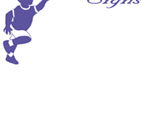|
The following "For Your Information" article appeared
in State Health Notes, Volume 23, #365 on February 11, 2002. It has been
reprinted with the permission
of the National Conference of State Legislatures, Copyright 2002.
State Health
Notes is a publication of the Forum for State Health Policy Leadership, an
information and research center at the
National
Conference of State Legislatures in Washington, DC. Anna C. Spencer is the author.
First Signs
would like to
thank the staff at State Health Notes for allowing us to reprint
their article.
FOR YOUR INFORMATION
From State Health Notes - February 11, 2002
First Signs: Educating Parents and Physicians about Autism
While most people might consider autism to be a relatively uncommon condition,
the truth is otherwise: Autism ranks third, behind mental retardation and
cerebral palsy, as the most common childhood developmental disability. According
to
estimates
by the Centers for Disease Control and Prevention, the prevalence of autism
is between 4.0 and 6.7 per 1000, with boys being three-to-four times more
likely than girls to be diagnosed with the disorder.
Characterized by communication
difficulties, social interaction problems and the need for sameness or repetition
in behavior, autism is a complex neurological
abnormality that manifests itself uniquely in each child. Often called
autism spectrum disorder to reflect the wide range of disabilities and intensity
of symptoms, autism has five distinct syndromes: autistic disorder, sometimes
called "classic" autism;
Asperger syndrome; childhood disintegrative disorder; Rett syndrome; and
pervasive developmental disorder, or "atypical" autism. While the origins
are unknown and a cure remains elusive, it is clear to many in the field
that early intervention
can markedly improve outcomes for children identified as having the disorder.
Enter
Nancy Wiseman. After leaving a corporate job to care for her autistic daughter,
the Merrimac, Massachusetts resident had an idea for an early intervention
and
outreach effort. The idea--which she called First
Signs--came to life four
years ago when she spoke at a developmental disabilities conference in
the nation’s
capital. In attendance were members of the
New Jersey Governor’s Council
on Autism, who took the concept for First Signs
back to their state for
review.
Last May, the council, along with the University of Medicine and
Dentistry of New Jersey (UMDNJ) and Parents of Autistic Children (POAC), a
New Jersey-based
nonprofit organization, ponied up $350,000 to launch the very first First
Signs pilot program.
The program’s primary goal is to improve early identification
of children with autism and other developmental disorders through what Elaine
Gabovitch,
First
Signs’ vice president, calls "a simple screening process." Both she and
Wiseman had repeatedly heard parents complain about the fact that their
pediatricians
weren’t taking their concerns about their children’s developmental delays
seriously. "At
such an early age, it’s very hard to tease out the subtle differences between
normal delay and serious developmental disabilities," Gabovitch noted.
It’s critical, she continued, to get an autistic child into treatment as
early as
possible. "The
window for intervention is very small. You really have to reach kids by
the time they are three."
Other goals: encourage timely referral of children
diagnosed with autism spectrum disorder to a community-based organization
called Early Intervention, and
educate parents about the key milestones of child development and alert them
to warning
signs that may require further evaluation. "While we don’t know how to
prevent autism," Gabovitch explained, "we do know that early and intensive
treatment can profoundly change the quality of life for autistic children
and their families."
To kick things off, program officials last May mailed
letters to 5,000 family physicians and pediatricians throughout the state,
offering them a free
screening kit to improve early detection of developmental disorders. The main
components
of the kit are a 20 minute educational video title On
the Spectrum: Children and Autism; a developmental milestones wall chart focusing on developmental
and autism screening tools; screening guidelines; and an early intervention
referral
guide, or "next step" directions, to help physicians help parents with
a newly diagnosed autistic child. Doctors who complete the course materials
in the
kits are eligible for continuing education credits. Response to the effort
has been
far-reaching. "We’ve received calls from all over the country requesting
the kits," Gabovitch said, and the eventual hope is "to take First Signs
nationwide."
On the parental end, information packets on early child
development were mailed to more than 90,000 residents with kids under the
age of three. "Parents
are the greatest advocates for their children," said Gabovitch. If they
are educated about the important developmental milestones, "they will speak
with their children’s doctors about their concerns and can be instrumental
in expanding the knowledge
base among physicians." +ACS
Back to top
| 



